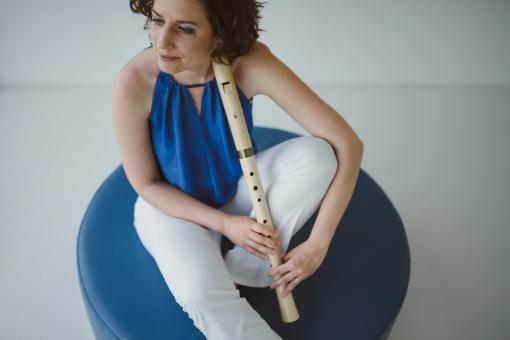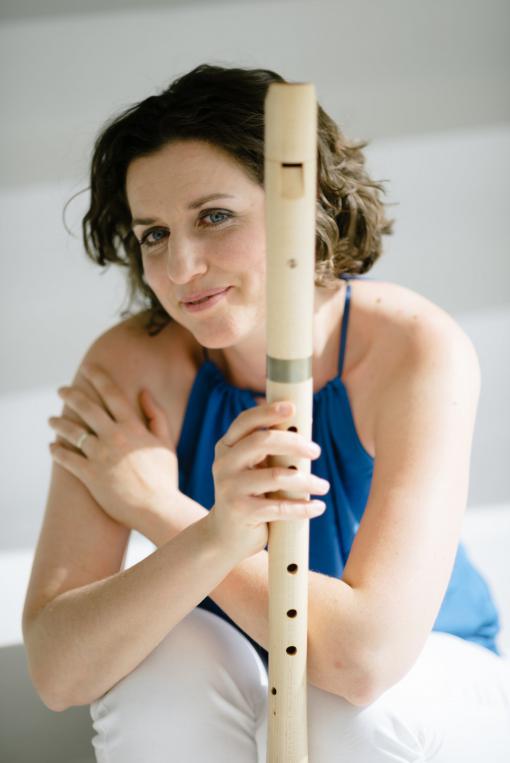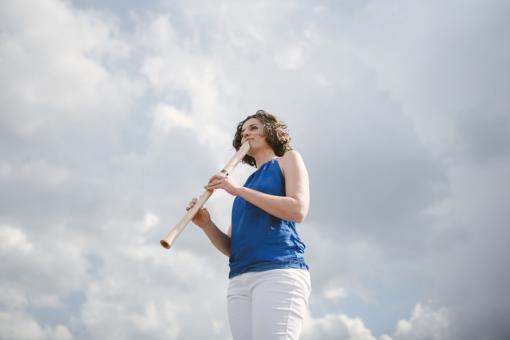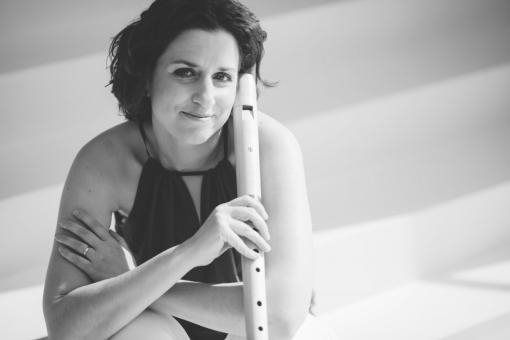The Prophet and the Wind is a multi-genre performance by flute player Martina Komínková. She created it in Italy and after its Italian premiere it will be presented in Brno for the first time. The Czech premiere will take place at Brno's Divadlo na Orlí Theatre on Sunday 3 November. The evening show starting at 7:00 pm is already sold out, but you can still buy tickets for the afternoon performance scheduled at 2:00 pm.
Martina, your show The Prophet and the Wind is based on an eponymous book by Stefano Biavaschi. Do you remember the moment you realized that you wanted to convert what the book appealed to you with into a show?
I had the idea of converting that book into a performance from the very first moment it got into my hand. However, I had to wait patiently for the right moment to make this dream come true – it took more than twelve years. What the book appealed to me with is not difficult to guess. It is the story of the flutist Nathan, to whom the wind speaks about various life topics, which is very interesting, tempting and personal to me.
"I have been preparing for it for a long time," you say in an interview with my colleague Radka Rozkovcová for Radio Proglas. So what did such “inner preparation” entail? Was the figure of Prophet Nathan in the Old Testament context important for you?
As a source I took only the book by Stefano Biavaschi. Just before I started the work as such, I reflected for about half a year about the form of elaborating, the type of music, the instrumentation itself. I did not want an ordinary performance, but my desire was to create a work that would give those who see it a space to pause, to personally reflect on the topics. I listened to various musicians and interviews with them and I was inspired by Rachel Claudio and the Chinese composer Tan Dun. The hardest thing was to overcome my own doubts as to whether I could do that; I had no experience of this kind.

You approached the author of the book with the idea. How did the first communication with him go?
Modern communication options are great, it was easy to find his Facebook contact. This first communication took place in 2016. I asked the author whether he would agree to convert the book into a performance. His response was more than enthusiastic, he wrote to me that he'd had the same idea himself, but so far he had not found a flutist in Italy who would want to make it happen.
How did your first meeting in person take place then?
We personally met for the first time only on the day of the Italian premiere, when he took quite a long journey from Milan to Loppiano near Florence. I was slightly tense because I hadn't consulted him on many things. For example, I chose the lyrics myself, but the Italian director Emma Pantano confirmed that they were sufficiently interconnected. The words of Stefano Biavaschi after the show were admiring, for example he mentioned that I chose some topics that were more difficult to process.
You prepared the show in Italy because you lived there with your whole family for a year. Did it have any advantages over the Czech environment?
Certainly, several of them. Firstly, it was a step out of established tracks and roles. After twenty years of intensive flute teaching, it was the first year I haven't done any teaching at all. That was why I had room for new things, such as writing. I also realized more deeply what I had observed for a long time – I was still more frequently fond of improvising and not just interpreting precisely written compositions. So, rather than being a flautist, I feel like an artist with a need for self-expression.

Your show consists of music, lyrics and video screening. The video shows moments of our contemporary world. So what exactly is the relationship between this visual component and the lyrics and your music?
The relationship is very close, because the artist Marta Carino not only followed on selected lyrics, but also had music at her disposal. The video thus shows what the text tells about, but the author puts her artistic insight into the work. For example, in the part that talks about death, she used the theme of threats of destroying the earth. We discussed everything together and I must admit it was one of the most difficult parts. After all, it was not always easy for me to express my inner views in Italian. However, I would like to mention the reaction of my friend Lau Kwok Hung, an artist from Loppiano, who perceived that all components were communicating with each other as a trialogue.
During the performance you appear on stage alone, using, as you say, "a whole series of flutes". What role do these different instruments play?
I mainly use recorders, most of them tenor and also soprano and alto. An interesting thing is the South American flute called quena, which I got in Italy from a friend who, at my request, bought it in Argentina and brought it here for me. At first I didn't manage to get a tone from it, but in the end it became a central flute on which I play all the sounds of the wind and the motif of the Prophet. With both ends open, quena provides interesting sound options that are really unexpected with the delay effect for listeners. I also use the Koshi chimes, which has a wonderful therapeutic sound, a rain stick, and I also sing. A sea sound recording will also appear.
Flute is a melodic instrument, you cannot play chords on it. Do you take this as a certain handicap, or is it in some way an advantage that you can benefit from?
At first I really took this as a handicap and wondered how to build music to be filled with harmony. But then it turned out to be unnecessary. I use delay effects to multiply and fill up the sound. In one case, I make live recording of a looper base layer. I also sing into the flute, so I have a double voice at once. I am satisfied with the resulting version because I see the Prophet as a simple flutist whose simple melodies are actually very powerful and impressive. The advantage of the flute is that it is very clear to hear every living emotion – you cannot really hide anything.
You managed to raise funds for the project through a campaign on HitHit. During the campaign, did you receive any interesting responses from friends or people who only learned about the project through the campaign?
We have received many positive responses. People wrote that they had the book at home and that they returned and read it again thanks to the project. Most interesting was the response from a friend of mine who is a musician: he wrote to us that the book accompanied him when he was travelling and playing around Europe, and he felt strongly connected with the story.

In Italy you lived in a community of families from all over the world that year. I know that your programme was very spiritual, but did your long-term stay together with families from other parts of the world inspire you also artistically?
I would say that for me the prevailing aspect was the fact of living with people from all over the world. They were not only families but also young people, there were a lot of groups. Yes, it inspired me, because there are many artists, both musicians and graphic artists, living and working in Loppiano. I found an entire team there to help me make the show happen.
After the June premiere in Italy, you have a Czech premiere in Brno, which means two performances in one day. What happens next to the project? When and where will additional shows take place?
I will also give a show in Kroměříž and then at the Salesian Theatre in Prague on 31 January. Shows at festivals or perhaps on the Night of Churches are under negotiation. If someone has appropriate premises and opportunity, we will be happy to come over. Since the book has been translated into most European languages, I can imagine another version, for example, in German. This performance is a long-term project for me. When I created the music, I clearly understood that this was what really made sense to me, what I wanted to bring to people. The Prophet says that if you play for people, you can give them life and, in a figurative sense, maybe a new hope.
Do you count on recording the performance, either in the form of a video or perhaps just the audio component on a CD?
Whatever will be, will be. Besides you, Milan, other people have already asked me about that. At the moment I tend more to make an audio recording. Everything is a matter of time and money. Basically, I look for sponsors all the time, because in order to reduce the cost of renting equipment, it is necessary to gradually purchase at least a part of my own equipment. Unfortunately, the Czech version of the book The Prophet and the Wind is already sold out and we would like to help it to be published again so that more people can read it.
In France there is a trio Nebula Machina formed of a double bass clarinet, a double bass and a trumpet, which also conceived their album Vento nebbie torrenti as samples of different sounds of the wind. Hence, it is a related topic. Can you imagine inviting some other instrument in addition to the flutes for this project?
That sounds really interesting, thanks for the great tip under the Christmas tree. Otherwise, at the beginning I thought about some form of cooperation, because I love it, I like to be inspired by interesting musicians. And it doesn't really matter what their instrument is. But in the end I really enjoy being on stage on behalf of myself, because the story of the Prophet tells me very much about my own life and artistic journey. Maybe I would like even more natural sounds in the performance, either authentically recorded or made by using non-traditional instruments.
































No comment added yet..